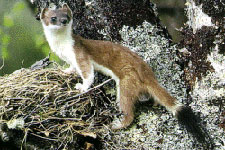Local Wildlife
Ermine

Scientific Name: Mustela erminea
Photo Source: Christine Doyle
Addt'l Info: Univ. of Michigan
The ermine is a member of the weasel family. In summer, its fur is a dark brown with an underside that ranges from cream to beige while in winter, its coat is white. However, regardless of the season, the tip of the tail remains black. Like their cousins, ermine have short legs, a long neck, and triangular head with small, rounded ears, beady eyes, and long whiskers. They are relatively quiet, rarely using vocalizations, and have keen sight, hearing, sense of smell.
Marshes, riparian woodlands, and open areas adjacent to forests or shrubby border areas are the favorite habitat of the ermine. Dens are often dug amongst tree roots or in hollow logs, however the existing burrow of a chipmunk or ground squirrel may also be pressed into service. Nests are commonly lined with dry grasses and leaves, pine needles, and fur or feathers from prey and side cavities are dug for use as food caches and latrines.
Mating season for ermine occurs in late spring or early summer. Both genders are promiscuous and may mate with several partners. Females produce one litter per year with the young born in April or May of the following year, just before mating begins again. Fetal development is suspended during the winter months, generally starting in late August and lasting for approx. eight months. Litter size averages four to nine young that are raised solely by the female.
Ermine are solitary creatures (except during mating season). Though the vast majority of their lives are spent on or under ground, ermine are capable of climbing trees and are surprisingly good swimmers. The ermine's slim, flexible body allows it to move swiftly both above ground and through underground burrows. They can also run easily across snow. When hunting for food or seeking a mate, they may travel 12km to 14km in one night.
